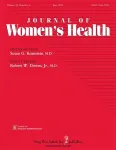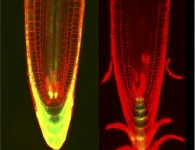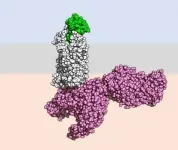(Press-News.org) We've seen robots take to the air, dive beneath the waves and perform all sorts of maneuvers on land. Now, researchers at UC Santa Barbara and Georgia Institute of Technology are exploring a new frontier: the ground beneath our feet. Taking their cues from plants and animals that have evolved to navigate subterranean spaces, they've developed a fast, controllable soft robot that can burrow through sand. The technology not only enables new applications for fast, precise and minimally invasive movement underground, but also lays mechanical foundations for new types of robots.
"The biggest challenges with moving through the ground are simply the forces involved," said Nicholas Naclerio, a graduate student researcher in the lab of UC Santa Barbara mechanical engineering professor Elliot Hawkes and lead author of a paper on the cover of the journal Science Robotics. Whereas air and water offer little resistance to objects moving through them, he explained, the subterranean world is another story.
"If you're trying to move through the ground, you have to push the soil, sand or other medium out of the way," Naclerio said.
Fortunately, the natural world provides numerous examples of underground navigation in the form of plants and fungi that build underground networks and animals that have mastered the ability to tunnel directly through granular media. Gaining a mechanical understanding of how plants and animals have mastered subterranean navigation opens up many possibilities for science and technology, according to Daniel Goldman, Dunn Family Professor of Physics at Georgia Tech.
"Discovery of principles by which diverse organisms successfully swim and dig within granular media can lead to development of new kinds of mechanisms and robots that can take advantage of such principles," he said. "And reciprocally, development of a robot with such capabilities can inspire new animal studies as well as point to new phenomena in the physics of granular substrates."
The researchers had a good head start with a vine-like soft robot designed in the Hawkes Lab that mimics plants and the way they navigate by growing from their tips, while the rest of the body remains stationary. In the subterranean setting, tip extension, according to the researchers, keeps resisting forces low and localized only to the growing end; if the whole body moved as it grew, friction over the entire surface would increase as more of the robot entered the sand until the robot could no longer move.
Burrowing animals, meanwhile, serve as inspiration for an additional strategy called granular fluidization, which suspends the particles in a fluid-like state and allows the animal to overcome the high level of resistance presented by sand or loose soil. The southern sand octopus, for instance, expels a jet of water into the ground, and uses its arms to pull itself into the temporarily loosened sand. That ability made its way onto the researchers' robot in the form of a tip-based flow device that shoots air into the region just ahead of the growing end, enabling it to move into that area.
"The biggest challenge we found and what took the longest to solve was when we switched to horizontal burrowing, our robots would always surface," Naclerio said. Whereas gases or liquids evenly flow over and under a traveling symmetric object, he explained, in fluidized sand, the distribution of forces is not as balanced, and creates a significant lift force for the horizontally travelling robot. "It's much easier to push the sand up and out of the way than it is to compact it down."
To understand the robot's behavior and the largely unexplored physics of air-aided intrusions, the team took drag and lift measurements as a result of different angles of airflow into from the tip of a solid rod shoved horizontally into sand.
"Frictional force response in granular materials greatly differs from that of Newtonian fluids, as intruding into sand can compact and stress large swaths of terrain in the direction of motion due to high friction," said Andras Karsai, a graduate student researcher in Goldman's lab. "To mitigate this, a low-density fluid that lifts and pushes grains away from an intruder will often reduce the net frictional stress it has to overcome."
Unlike with gas or liquid, where a downward fluid jet would create lift for the travelling object, in sand the downward air flow reduced the lift forces and excavated the sand below the robot's growing tip. This, combined with inspiration from the sandfish lizard, whose wedge-shaped head favors downward movement, allowed the researchers to modulate the resisting forces and keep the robot moving horizontally without rising out of the sand.
A small, exploratory, soft robot such as this has a variety of applications where shallow burrowing through dry granular media is needed, such as soil sampling, underground installation of utilities and erosion control. Tip extension enables changes in direction, while also allowing the body of the robot to modulate how firmly anchored it is in the medium -- control that could become useful for exploration in low gravity environments. In fact, the team is working on a project with NASA to develop burrowing for the moon or even more distant bodies, like Enceladus, a moon of Jupiter.
"We believe burrowing has the potential to open new avenues and enable new capabilities for extraterrestrial robotics," Hawkes said.
INFORMATION:
Research for this paper was conducted also by Mason Murray-Cooper, Yasemin Ozkan-Aydin and Enes Aydin at Georgia Institue of Technology.
In a study of more than 10,600 adult patients hospitalized with COVID-19, women had significantly lower odds than men of in-hospital mortality. They also had fewer admissions to the intensive care unit and less need for mechanical ventilation. Women also had significantly lower odds of major adverse events, including acute cardiac injury, acute kidney injury, and venous thromboembolism, according to an article in the peer-reviewed Journal of Women's Health. Click here to read the article now.
"This comprehensive analysis is the largest study to date that directly assesses the impact of sex on COVID-19 outcomes," ...
Boston - New study results indicate that different comorbid conditions affecting individuals diagnosed with COVID-19 may impact how long they continue to receive positive SARS-CoV-2 polymerase chain reaction (PCR) test results. Individuals diagnosed with COVID-19 who are aged 60+, have three or more chronic medical conditions, particularly diabetes, obesity, rheumatologic disease, or an organ transplant, have positive PCR tests for longer periods of time compared to younger individuals without these comorbidities. However, the data showed no significant difference in the duration of positive PCR tests results by the degree of immunocompromise or for individuals receiving chemotherapy or steroids ...
EAST LANSING, Mich. - The original Star Trek television series took place in a future when space is the final frontier, but humanity hasn't reached that point quite yet.
As researchers like Michigan State University entomologists Sarah Smith and Anthony Cognato are reminding us, there's still plenty to discover right here on Earth.
Working in Central and South America, the duo discovered more than three dozen species of ambrosia beetles -- beetles that eat ambrosia fungus -- previously unknown to science. Smith and Cognato described these new species on June 16 in the journal ZooKeys.
The Spartans also selected ...
Researchers from Skoltech and their colleagues from the UK have managed to create a stable giant vortex in interacting polariton condensates, addressing a known challenge in quantized fluid dynamics. The findings open possibilities in creating uniquely structured coherent light sources and exploring many-body physics under unique extreme conditions. The paper was published in the journal Nature Communications.
In fluid dynamics, a vortex is a region where a fluid revolves around a point (2D) or a line (3D); you've clearly seen one in your sink ...
Ikoma, Japan - Humans pride themselves on being able to multitask, especially under pressure. But it turns out that we aren't the only ones who are organized: researchers from Japan have discovered that plants balance genome maintenance with organ growth by organizing different responses to DNA damage.
In a study published in Science Advances, a research team led by Nara Institute of Science and Technology has revealed that plants use combined control of the plant hormones cytokinin and auxin to organize DNA damage responses while maintaining growth.
Plants are highly adaptable organisms that never stop growing, thanks largely to the functions carried out by their roots. Because of the essential role that roots play in plant growth, ...
A new study using cells, transgenic mouse models, and cultured human lung tissue provides evidence that the ability to trigger programmed cell death (apoptosis) may enable highly pathogenic coronaviruses to spread within their hosts so successfully. Targeting this process may reduce the severity of coronavirus diseases, the study goes on to show. While scientists have been aware that highly pathogenic coronaviruses leave substantial cell death in their wake as they infiltrate the body, the importance of apoptosis to the internal spread of coronavirus infections ...
Nanoengineers at the University of California San Diego have developed immune cell-mimicking nanoparticles that target inflammation in the lungs and deliver drugs directly where they're needed. As a proof of concept, the researchers filled the nanoparticles with the drug dexamethasone and administered them to mice with inflamed lung tissue. Inflammation was completely treated in mice given the nanoparticles, at a drug concentration where standard delivery methods did not have any efficacy.
The researchers reported their findings in Science Advances on June 16.
What's special ...
Parenting is one of life's greatest joys, right? Not for everyone. New research from Michigan State University psychologists examines characteristics and satisfaction of adults who don't want children.
As more people acknowledge they simply don't want to have kids, Jennifer Watling Neal and Zachary Neal, both associate professors in MSU's department of psychology, are among the first to dive deeper into how these "child-free" individuals differ from others.
"Most studies haven't asked the questions necessary to distinguish 'child-free' individuals -- those who choose not to have children -- from other types of nonparents," Jennifer Watling Neal said. ...
Chemokine receptors, located at the surface of many immune cells, play an important role in their function. Chemokines are small proteins that bind to these receptors and control the movement and behaviour of white blood cells. However, despite the importance of this family of receptors, their activation mechanism remains poorly understood. In Switzerland, a research consortium from the University of Geneva (UNIGE), the Biozentrum of the University of Basel, and the Paul Scherrer Institute (PSI) in Villigen has succeeded in decoding the activation mechanism of the CCR5 receptor, a member of this family implicated in several diseases such as HIV/AIDS, cancer, and the respiratory ...
New research published this week challenges a popular belief that intermittent fasting diets such as alternate day fasting or the '5:2' are the most effective ways to lose weight.
Over recent years, diets which see people fast on a few days each week have increased in popularity, reinforced by images of people's miraculous weight transformations, and backed by celebrity endorsements.
However, evidence to date about the effectiveness of fasting compared with more traditional diets which aim to reduce calorie intake over the course of a full week has been limited.
Published in the prestigious journal Science Translational Medicine, the new study from a team of physiologists at the University of Bath builds this evidence and indicates that there is 'nothing ...




